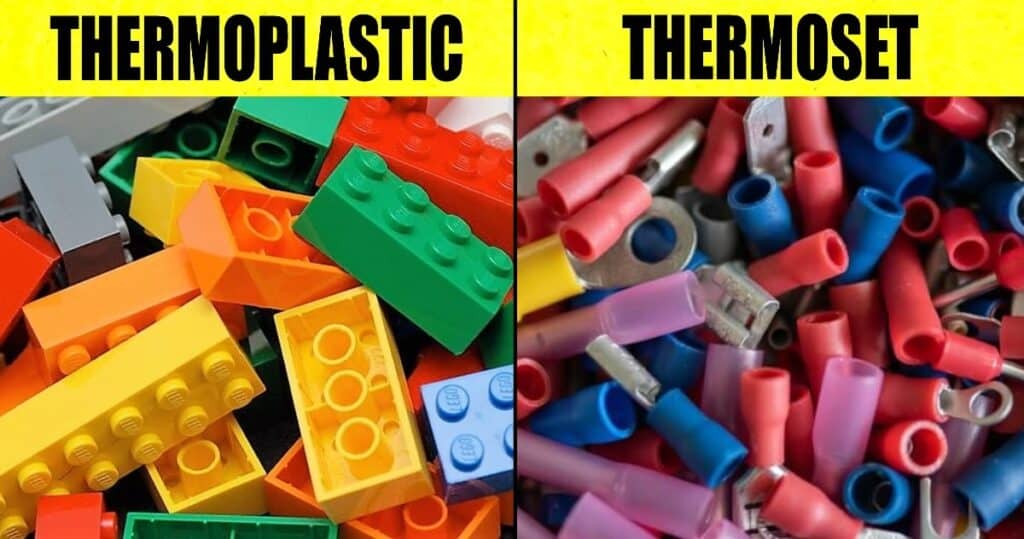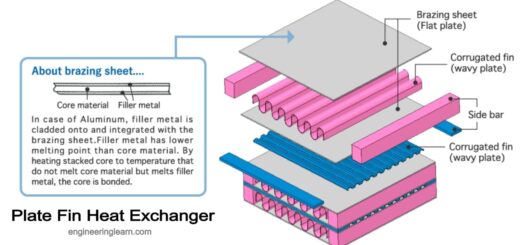What is a Thermoplastic? | What is a Thermosetting? | Thermoplastic vs Thermoset

A. Introduction Thermoplastic vs Thermoset
What is a Thermoplastic? | What is a Thermosetting? | Thermoplastic vs Thermoset: – Thermoplastics and thermosetting polymers are different types of plastic that go through different manufacturing processes and have varying qualities based on the constituent elements and manufacturing methods. The terms thermoplastic and thermoset describe how a material can be processed when the temperature changes.
What is a Thermoplastic?
A thermoplastic is a form of plastic composed of polymer resins that soften when heated and harden when cooled. When thermoplastics are heated, their physical properties change, but their chemical nature remains the same, and they become a homogenised liquid that can be reshaped, resized, remoulded, and recycled.
Thermoplastic materials are available in many compositions, crystalline structures, and densities, each with advantages. A key feature is the reversibility of thermoplastics, or their capacity to be reheated, melted again, and reshaped. This enables further processing of the same material, even after it has been solidified. Extrusion, thermoforming, and injection moulding rely on resin behaviour like this. Polyethene (PE), polycarbonate (PC), and polyvinyl chloride (PVC) are some typical thermoplastic polymers (PVC).
What is a Thermosetting?
When heated or chemically applied, a thermosetting resin, also known as a thermosetting polymer, is a liquid material that hardens permanently. The thermoset forms into the desired shape when heated and placed in a mould. Still, the solidification process involves the formation of crosslinks, which hold the molecules in place and alter the material’s basic character, preventing it from melting. As a result, unlike a thermoplastic, a thermoset cannot be returned to its original state, making the process irreversible. Thermosets become set and fixed in a precise shape when heated.
Thermosets dissolve without entering a fluid phase when they are overheated. Compression moulding, resin transfer moulding, extrusion, manual lay-up, and filament winding all rely on the behaviour of thermosetting polymers. Epoxy, polyimide, and phenolic are common thermosets, and many of them are important in composites.
B. Process Thermoplastic vs Thermoset
Thermoplastic Process
- Extrusion moulding, injection moulding, thermoforming, and vacuum forming are all methods for processing thermoplastics.
- Granular material is supplied into the mould in the shape of spherical granules with a diameter of around 3 mm. The granules are then heated to the melting point, which necessitates extremely high temperatures. • Because thermoplastics are excellent thermal insulators, cooling takes longer during the curing process than other polymers. To produce a high output rate, fast cooling is commonly used by spraying cold water or plunging it into water baths.
- Cold air is blown onto the surface of thermoplastic plastic films to cool them. The plastic shrinks as it cools, with shrinkage rates ranging from 0.6 percent to 4 percent depending on the type. The rate of cooling and shrinkage has a distinct effect on the material’s crystallisation and internal structure, which is why thermoplastic shrinkage rate is always mentioned.
Thermosetting Process
- The first stage is commonly referred to as resole, where during this stage,e the resin is in an insoluble and fusible condition or state.
- The thermosets are only partially soluble in the second stage and tend to take on the characteristics of a thermoplastic with reversible modifications.
- The cross-linking reaction occurs in the final stage, and the ultimate structure of the thermosets is built. This mostly entails the moulding process, carried out at a controlled temperature and with some pressure applied.
- A three-dimensional internal network structure of heavily cross-linked polymer chains will be present in the finished product. The product cannot be thermally distorted at this point.
- Thermosetting resins are heated while in their liquid state. Depending on the desired output, curing agents, inhibitors, hardeners, or plasticisers are added to the resin and reinforcement or fillers.
C. Properties Thermoplastic vs Thermoset
Thermoplastic Properties
Fibres are used to stabilise many thermoplastic polymers. Reinforcement enhances physical qualities, particularly heat deflection temperature. Glass fibres are the most often used reinforcing material. Thermoplastic polymers’ wear and abrasion resistance can be improved using aramid reinforcing. Although any thermoplastic polymer can be used with fibres, the following are the most common. Polyamide polymers use glass fibres to control brittleness. Tensile strengths are increased by a factor of three, and heat deflection temperature increases from 150 to 500oF. Polycarbonate compounds using 10, 20, 30 and 40% glass fibre loading greatly improve their physical properties. Other polymers benefiting from the addition of glass fibres include polyphenylene sulfide, polypropylene and polyethersulfone.
Polymers are frequently used as a substitute for metal in structural applications. In most cases, replacing a polymer section with a metallic section result in weight savings. Furthermore, unlike metals, polymers may be easily shaped into geometries that are difficult to produce with metals. The engineer can design an attractive shape that favours plastic forming with a polymer, resulting in cost and weight savings and a cosmetic improvement. Further cost savings are realised because the polymer part, unlike the corresponding metal part, does not require painting for corrosion protection. The polymer will be chosen based on mechanical requirements and the temperature and chemical environment in which it will be used.
Thermosetting Properties
The cross-linked molecular structure is the essential property of thermosetting polymers. Because of this cross-linked structure, the products are made of thermosetting materials with a single big macromolecule.
Because of their cross-linked molecular structure, thermosetting materials are less soluble in common solvents than thermoplastics. Thermosetting materials can withstand temperatures much higher than normal. However, due to cross-linked structures, thermosetting materials cannot be re-melted. Thermosets have a brittle structure and do not have the same tensile properties as thermoplastics. Because of their cross-linked molecular structure, thermosets offer more stiffness and superior mechanical properties than thermoplastics. The elasticity modulus of thermosetting materials is 2-3 times that of thermoplastics.
D. Applications Thermoplastic vs Thermoset
Thermoplastic Polymers Applications
Thermoplastics are almost inevitable in today’s world. They are used everywhere, from packaging and storage materials to consumer goods, medical equipment to machine parts, electrical/electronic components to automotive covers.
- The automobile industry is the market leader in thermoplastics. One of the most extensively used materials in the business is polypropylene. Because of its enhanced strength, stiffness, and thermal capacity, it can be employed in automobile bumpers and battery boxes.
- For electrical insulation, thermoplastic polymers with high thermal resistance are utilised. This is done with polystyrene (in the form of expanded polystyrene foam), polypropylene, and polyvinyl chloride (PVC).
- Nylons are known for their excellent strength, durability, and abrasion resistance. As a result, gear wheels, power tool casings, and other mechanical parts are made from it. Machine screws are also made from them.
- Because of their high degree of purity, recyclability, good elasticity, ease of sterilisation, and low cost, thermoplastic elastomers are widely utilised in medical equipment. Syringes, medical tubing (catheters, drainage tubes, tourniquets, and so on), and glucose measurement ces all employ them (vial caps, soft-touch cushioning, gaskets, etc.).
- Thermoplastic polymers, when adopted for packaging, are lightweight, safe and hygienic, extremely convenient for use, and aid with preservation.
Thermosetting Polymers Applications
- Heat-resistant thermosetting plastics are used to create kettles, plugs, and laptop chargers, among other things.
- Electrical fittings, handles and control knobs, and adhesives employ them.
- Because of its high chemical and thermal stability, superior strength, hardness, and moldability, thermoset components are widely utilitarianism of industries, including automotive, appliance, electrical, lighting, and energy.
- These are used to make panels for construction equipment.
- Feeding troughs and motors are examples of agricultural equipment that use them.
E. Advantages Thermoplastic vs Thermoset
Thermoplastic Advantages
- Processing that saves energy
- A wide range of advantageous features
- High-volume, high-precision manufacturing at a cheaper cost
- Metals can be replaced with a variety of kinds, resulting in significant weight savings.
- In comparison to most metals, it has a higher fatigue resistance.
- It can withstand more deflection without deforming than most metals.
Thermosetting Plastic Advantages
- Allows for product design flexibility.
- It can be moulded to a variety of tolerances.
- Electrical insulating qualities are excellent.
- Greater resistance to extreme heat
- Dimensional stability is excellent.
- Exceptionally corrosion-resistant
- Thermal conductivity is low.
- To optimise product performance, it has a high strength-to-weight ratio.
- Water-resistant
Conclusion: ( Thermoplastic vs Thermoset )
Thermosetting plastics and thermoplastics are both polymers, but they react to heat differently. Thermoplastics can melt when exposed to heat after curing, but thermoset plastics preserve their shape and remain solid. Thermoplastics are good for recycled materials applications because they have a low melting point. Thermoset plastics, on the other hand, are more robust since they can resist high temperatures without losing their shape.
Content Source: – ulprospector, osborneindustries, reliantplastics
Image Source: – wikipedia, adrecoplastics












